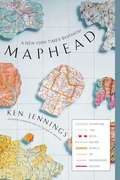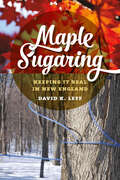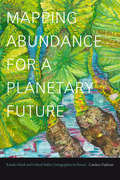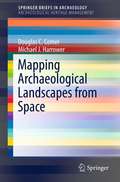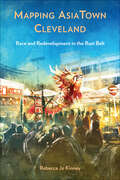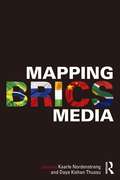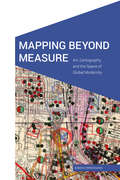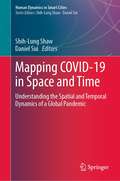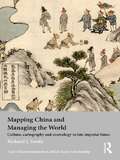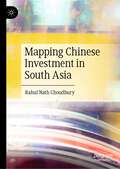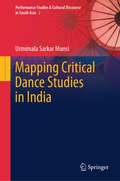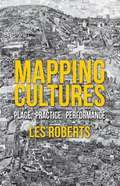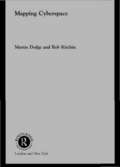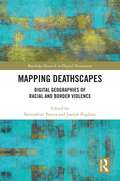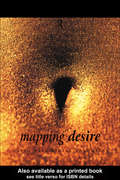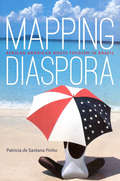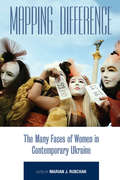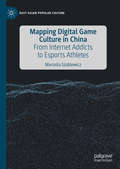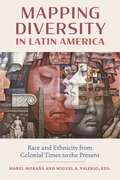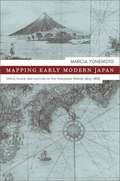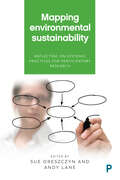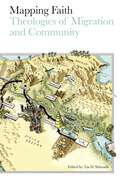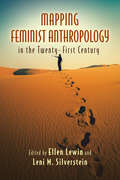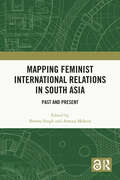- Table View
- List View
Maphead: Charting the Wide, Weird World of Geography Wonks
by Ken JenningsRecord-setting Jeopardy! champion and New York Times bestselling author of Planet Funny Ken Jennings explores the world of maps and map obsessives, &“a literary gem&” (The Atlantic). Ken Jennings takes readers on a world tour of geogeeks from the London Map Fair to the bowels of the Library of Congress, from the prepubescent geniuses at the National Geographic Bee to the computer programmers at Google Earth. Each chapter delves into a different aspect of map culture: highpointing, geocaching, road atlas rallying, even the “unreal estate” charted on the maps of fiction and fantasy. Jennings also considers the ways in which cartography has shaped our history, suggesting that the impulse to make and read maps is as relevant today as it has ever been. From the “Here be dragons” parchment maps of the Age of Discovery to the spinning globes of grade school to the postmodern revolution of digital maps and GPS, Maphead is filled with intriguing details, engaging anecdotes, and enlightening analysis. If you’re an inveterate map lover yourself—or even if you’re among the cartographically clueless who can get lost in a supermarket—let Ken Jennings be your guide to the strange world of mapheads.
Maple Sugaring: Keeping It Real in New England (Garnet Books)
by David K. LeffThe art and science of maple syrup, and stories from the people who make it
Mapmatics: A Mathematician's Guide to Navigating the World
by Paulina Rowińska“I love maps. I love math. And gosh, do I love this book, which so beautifully and clearly sounds the depths of both.” —Ben Orlin, author of Math with Bad DrawingsExplore the surprising connections between math and maps—and the myriad ways they’ve shaped our world and us.Why are coastlines and borders so difficult to measure? How does a UPS driver deliver hundreds of packages in a single day? And where do elusive serial killers hide? The answers lie in the crucial connection between maps and math.In Mapmatics, mathematician Paulina Rowińska leads us on a riveting journey around the globe to discover how maps and math are deeply entwined, and always have been. From a sixteenth-century map, an indispensable navigation tool that exaggerates the size of northern countries, to public transport maps that both guide and confound passengers, to congressional maps that can empower or silence whole communities, she reveals how maps and math have shaped not only our sense of space but our worldview. In her hands, we learn how to read maps like a mathematician—to extract richer information and, just as importantly, to question our conclusions by asking what we don’t see.Written with authority and compassion, wit and unforgettable storytelling, this is math exposition at its best. By unpacking the math behind the maps we depend on, Mapmatics illuminates how our world works and, ultimately, how we can better look after it.
Mapping Abundance for a Planetary Future: Kanaka Maoli and Critical Settler Cartographies in Hawai'i
by Candace FujikaneIn Mapping Abundance for a Planetary Future, Candace Fujikane contends that the practice of mapping abundance is a radical act in the face of settler capital's fear of an abundance that feeds. Cartographies of capital enable the seizure of abundant lands by enclosing "wastelands" claimed to be underdeveloped. By contrast, Kanaka Maoli (Native Hawaiian) cartographies map the continuities of abundant worlds. Vital to restoration movements is the art of kilo, intergenerational observation of elemental forms encoded in storied histories, chants, and songs. As a participant in these movements, Fujikane maps the ecological lessons of these elemental forms: reptilian deities who protect the waterways, sharks who swim into the mountains, the navigator Māui who fishes up the islands, the deities of snow and mists on Mauna Kea. The laws of these elements are now being violated by toxic waste dumping, leaking military jet fuel tanks, and astronomical-industrial complexes. As Kānaka Maoli and their allies stand as land and water protectors, Fujikane calls for a profound attunement to the elemental forms in order to transform climate events into renewed possibilities for planetary abundance.
Mapping Archaeological Landscapes from Space
by Douglas C. Comer Michael J. HarrowerGiven the rising awareness and interest in aerial and satellite remote sensing, there is a need to familiarize archaeologists with the basic principles and applications of what have become the most useful technologies. This volume, in the Springerbriefs Archaeologial Heritage Management series, accomplishes this. Contributions to the volume come from those who have been active in developing key technologies as well as those who have been most successful in applying them. Leading experts, most of them from NASA, concisely describe what needs to be understood in order to utilize images produced from data collected by the most important airborne and satellite sensing devices.. Exemplary applications of these technologies are presented in brief by archaeologists who have made notable discoveries using them or have contributed to archaeological resource preservation. Among the technologies examined are those that are undergoing rapid refinement and will be carried by an increasing number of aerial and satellite platforms, such as synthetic aperture radar (SAR), Lidar, and multispectral/hyperspectral sensors, as well as older space technologies now made more useful by the availability of increasingly sophisticated computer hardware and software. Of particular importance is the ability to model how development in and around archaeological sites and landscapes can damage or destroy archaeological materials. Nurturing the development and application of space and aerial technologies in archaeology is therefore a matter of the greatest urgency, an appropriate goal to adopt by governments and universities at the 40th anniversary of the World Heritage Convention. Researchers gain a sense of what is possible by the use of these technologies, and why they should be used.
Mapping AsiaTown Cleveland: Race and Redevelopment in the Rust Belt (Asian American History & Cultu)
by Rebecca Jo KinneyCleveland, Ohio is not a location that most people associate with Asian American placemaking. However, on Cleveland’s East Side, multigenerational and panethnic Asian American residents and business owners are building community in the AsiaTown neighborhood. Mapping AsiaTown Cleveland foregrounds the importance of region in racial formation and redevelopment as it traces the history of racial segregation and neighborhood diversity. Mapping AsiaTown Cleveland challenges ideas about the invisibility of Asian Americans in the urban Midwest by linking the contemporary development of Cleveland’s “AsiaTown” to the multiple and fragmented histories of Cleveland’s Asian American communities from the 1940s to present day. Kinney’s sharp insights illustrate how region matters for Japanese Americans who resettled from concentration camps and Chinese Americans food purveyors, as well as the ways in which Asian American community leaders have had to fight for visibility and representation in city planning—even as the Cleveland Asian Festival is branded as a marquee “diversity” event for the city. Mapping AsiaTown Cleveland recognizes the vibrant Asian American community formations and belonging that have developed in seemingly unexpected spaces and places. In the series Asian American History and Culture
Mapping BRICS Media (Internationalizing Media Studies)
by Daya Kishan Thussu Kaarle NordenstrengMapping BRICS Media is the first comprehensive and comparative study of the emerging media landscape in the world’s most dynamic and fastest growing markets. This pioneering collection focuses on one of the key topics in contemporary international relations - the emergence of BRICS (Brazil, Russia, India, China and South Africa) - a grouping that includes some of the world’s largest populations and fastest growing economies. The volume brings together leading scholars, mainly from the BRICS nations, to examine how the emergence of the BRICS media will impact on global media and communication. Contextualizing the rise of the BRICS nations within the broader shifts in global power relations, the chapters investigate the unprecedented growth of the BRICS media within a ‘multi-polar’ world, evaluating the media landscapes in the individual BRICS countries, their histories, and their journalism practices, as well as analyzing emerging inter-BRICS media relationships. Accessible and comprehensive, the book provides a critical guide to the complex debates about the impact of the ‘rise of the rest’ on the media globe and how far this poses a challenge to the Western-dominated world order and its media systems.
Mapping Beyond Measure: Art, Cartography, and the Space of Global Modernity (Cultural Geographies + Rewriting the Earth)
by Simon FerdinandOver the last century a growing number of visual artists have been captivated by the entwinements of beauty and power, truth and artifice, and the fantasy and functionality they perceive in geographical mapmaking. This field of &“map art&” has moved into increasing prominence in recent years yet critical writing on the topic has been largely confined to general overviews of the field. In Mapping Beyond Measure Simon Ferdinand analyzes diverse map-based works of painting, collage, film, walking performance, and digital drawing made in Britain, Japan, the Netherlands, Ukraine, the United States, and the former Soviet Union, arguing that together they challenge the dominant modern view of the world as a measurable and malleable geometrical space. This challenge has strong political ramifications, for it is on the basis of modernity&’s geometrical worldview that states have legislated over social space; that capital has coordinated global markets and exploited distant environments; and that powerful cartographic institutions have claimed exclusive authority in mapmaking.Mapping Beyond Measure breaks fresh ground in undertaking a series of close readings of significant map artworks in sustained dialogue with spatial theorists, including Peter Sloterdijk, Zygmunt Bauman, and Michel de Certeau. In so doing Ferdinand reveals how map art calls into question some of the central myths and narratives of rupture through which modern space has traditionally been imagined and establishes map art&’s distinct value amid broader contemporary shifts toward digital mapping.
Mapping COVID-19 in Space and Time: Understanding the Spatial and Temporal Dynamics of a Global Pandemic (Human Dynamics in Smart Cities)
by Daniel Sui Shih-Lung ShawThis book describes the spatial and temporal perspectives on COVID-19 and its impacts and deepens our understanding of human dynamics during and after the global pandemic. It critically examines the role smart city technologies play in shaping our lives in the years to come. The book covers a wide-range of issues related to conceptual, theoretical and data issues, analysis and modeling, and applications and policy implications such as socio-ecological perspectives, geospatial data ethics, mobility and migration during COVID-19, population health resilience and much more. With accelerated pace of technological advances and growing divide on political and policy options, a better understanding of disruptive global events such as COVID-19 with spatial and temporal perspectives is an imperative and will make the ultimate difference in public health and economic decision making. Through in-depth analyses of concepts, data, methods, and policies, this book stimulates future studies on global pandemics and their impacts on society at different levels.
Mapping China and Managing the World: Culture, Cartography and Cosmology in Late Imperial Times (Asia's Transformations/critical Asian Scholarship Ser.)
by Richard J. SmithFrom the founding of the Qin dynasty in 221 BCE to the present, the Chinese have been preoccupied with the notion of ordering their world. Efforts to create and maintain order are expressed not only in China’s bureaucratic institutions and methods of social and economic organization but also in Chinese philosophy, religious and secular ritual, and comprehensive systems of classifying all natural and supernatural phenomena. Mapping China and Managing the World focuses on Chinese constructions of order (zhi) and examines the most important ways in which elites in late imperial China sought to order their vast and variegated world. This book begins by exploring the role of ancient texts and maps as the two prominent symbolic devices that the Chinese used to construct cultural meaning, and looks at how changing conceptions of ‘the world’ shaped Chinese cartography, whilst both shifting and enduring cartographic practices affected how the Chinese regarded the wider world. Richard J. Smith goes on to examine the significance of ritual in overcoming disorder, and by focusing on the importance of divination shows how Chinese at all levels of society sought to manage the future, as well as the past and the present. Finally, the book concludes by emphasizing the enduring relevance of the Yijing (Classic of Changes) in Chinese intellectual and cultural life as well as its place in the history of Sino-foreign interactions. Bringing together a selection of essays by Richard J. Smith, one of the foremost scholars of Chinese intellectual and cultural history, this book will be welcomed by Chinese and East Asian historians, as well as those interested more broadly in the culture of China and East Asia.
Mapping Chinese Investment in South Asia
by Rahul Nath ChoudhuryThis book attempts to capture the tremendous growth in Chinese investment in the South Asian region in the recent past. It makes country-wise analysis of the factors that led to the growth of Chinese investment in the region and explores the nature and role of such investment in expanding trade in the region. It also discusses in detail the Chinese infrastructure investment through Belt and Road Initiative (BRI). Interestingly, despite being the major investor in several countries, Chinese investment has been seen with some level of doubt. Apprehension about Chinese investment has forced countries to suspend China-funded projects or amend their investment policies. This book tries to address these crucial issues while exploring and analyzing the causes and effects of the same.
Mapping Critical Dance Studies in India (Performance Studies & Cultural Discourse in South Asia #2)
by Urmimala Sarkar MunsiThis book provides a critical understanding of dance studies in India, bringing together various embodied practices identified loosely as dance. It suggests an alternative reading of the history of patronage, policies, and institutionalized understanding of categories such as classical, folk, modern, popular, and Bollywood that hierarchizes some dances as 'more' dance than others. It is of great interest to scholars looking at performing arts such as dance as a tool for identity assertions. It offers diverse possibilities of understanding dance through its inherent sociopolitical possibilities as a participatory or presentational tool for communication. The multidisciplinary approach brings together perspectives from critical dance studies, anthropology, history, and gender studies to connect embodied archives of different communities to create an intersectional methodology of studying dance in India as a powerful but marginal expressive art practice. Accessible at multiple levels, thecontent is relevant for undergraduate and postgraduate students, as well as researchers across dance, dance education, theatre, and performance studies.
Mapping Cultures
by Les RobertsMapping Cultures is a collection of essays exploring the diverse practices and cultures of mapping on the one hand, and the mapping of different forms of cultural practice on the other. The book draws on a wide range of disciplinary perspectives, including critical cartography, social anthropology, film and cultural studies, literary studies, art and visual culture, marketing, architecture, and popular music studies. Underpinning the theoretical and methodological approaches of all the contributions is a close engagement with mapping both as a mode of cultural and spatial analysis, and as a point of critical intersection in which ideas and practices of cartography are challenged, re-envisioned and brought into play with a broad range of theoretical perspectives. The collection is loosely organized around three main thematic sections: place, text, and topography; performance, memory, and location; and practice, apparatus, and methodology.
Mapping Cyberspace
by Rob Kitchin Martin DodgeMapping Cyberspace is a ground-breaking geographic exploration and critical reading of cyberspace, and information and communication technologies. The book:* provides an understanding of what cyberspace looks like and the social interactions that occur there* explores the impacts of cyberspace, and information and communication technologies, on cultural, political and economic relations* charts the spatial forms of virutal spaces* details empirical research and examines a wide variety of maps and spatialisations of cyberspace and the information society* has a related website at http://www.MappingCyberspace.com.This book will be a valuable addition to the growing body of literature on cyberspace and what it means for the future.
Mapping Deathscapes: Digital Geographies of Racial and Border Violence
by Suvendrini PereraThis volume offers a critical and creative analysis of the innovations of Deathscapes, a transnational digital humanities project that maps the sites and distributions of custodial deaths in locations such as police cells, prisons and immigration detention centres. An international team of authors take a multidisciplinary approach to questions of race, geographies of state violence and countermaps of resistance across North America, Australia and Europe. The book establishes rich lines of dialogic connection between digital and other media by incorporating both traditional scholarly resources and digital archives, databases and social media. Chapters offer a comprehensive mapping of the key attributes through which racial violence is addressed and contested through digital media and articulate, in the process, the distinctive dimensions of the Deathscapes site. This interdisciplinary volume will be an important resource for scholars, students and activists working in the areas of Cultural Studies, Media and Visual Studies, Indigenous Studies, Refugee Studies and Law.
Mapping Desire: Geographies Of Sexualities
by Gill Valentine David BellThis is the first book to explore sexualities from a geographical perspective. The nature of place and notions of space are of increasing centrality to cultural and social theory. Mapping Desire presents the rich and diverse world of contemporary sexuality, exploring how the heterosexual body has been appropriated and resisted on the individual, community and city scales. The geographies presented here range across Europe, America, Australasia, Africa, the Pacific and the imaginary, cutting across city and country and analysing the positions of gay men, lesbians, bisexuals and heterosexuals. The contributors ring different interests and approaches to bear on theoretical and empirical material from a wide range of sources. The book is divided into four sections: cartographies/identities; sexualised spaces: global/local; sexualised spaces: local/global; sites of resistance. Each section is separately introduced. Beyond the bibliography, an annotated guide to further reading is also provided to help the reader map their own way through the literature.
Mapping Diaspora: African American Roots Tourism in Brazil
by Patricia de PinhoBrazil, like some countries in Africa, has become a major destination for African American tourists seeking the cultural roots of the black Atlantic diaspora. Drawing on over a decade of ethnographic research as well as textual, visual, and archival sources, Patricia de Santana Pinho investigates African American roots tourism, a complex, poignant kind of travel that provides profound personal and collective meaning for those searching for black identity and heritage. It also provides, as Pinho's interviews with Brazilian tour guides, state officials, and Afro-Brazilian activists reveal, economic and political rewards that support a structured industry.Pinho traces the origins of roots tourism to the late 1970s, when groups of black intellectuals, artists, and activists found themselves drawn especially to Bahia, the state that in previous centuries had absorbed the largest number of enslaved Africans. African Americans have become frequent travelers across what Pinho calls the "map of Africanness" that connects diasporic communities and stimulates transnational solidarities while simultaneously exposing the unevenness of the black diaspora. Roots tourism, Pinho finds, is a fertile site to examine the tensions between racial and national identities as well as the gendered dimensions of travel, particularly when women are the major roots-seekers.
Mapping Difference: The Many Faces of Women in Contemporary Ukraine
by Marian J. RubchakDrawn from various disciplines and a broad spectrum of research interests, these essays reflect on the challenging issues confronting women in Ukraine today. The contributors are an interdisciplinary, transnational group of scholars from gender studies, feminist theory, history, anthropology, sociology, women's studies, and literature. Among the issues they address are: the impact of migration, education, early socialization of gender roles, the role of the media in perpetuating and shaping negative stereotypes, the gendered nature of language, women and the media, literature by women, and local appropriation of gender and feminist theory. Each author offers a fresh and unique perspective on the current process of survival strategies and postcommunist identity reconstruction among Ukrainian women in their current climate of patriarchalism.
Mapping Digital Game Culture in China: From Internet Addicts to Esports Athletes (East Asian Popular Culture)
by Marcella SzablewiczIn this book, Marcella Szablewicz traces what she calls the topography of digital game culture in urban China, drawing our attention to discourse and affect as they shape the popular imaginary surrounding digital games. Szablewicz argues that games are not mere sites of escape from Real Life, but rather locations around which dominant notions about failure, success, and socioeconomic mobility are actively processed and challenged. Covering a range of issues including nostalgia for Internet cafés as sites of youth sociality, the media-driven Internet addiction moral panic, the professionalization of e-sports, and the rise of the self-proclaimed loser (diaosi), Mapping Digital Game Culture in China uses games as a lens onto youth culture and the politics of everyday life in contemporary China. Based on ethnographic fieldwork conducted between 2009 and 2015 and first-hand observations spanning over two decades, the book is also a social history of urban China’s shifting technological landscape.
Mapping Diversity in Latin America: Race and Ethnicity from Colonial Times to the Present
by Mabel Moraña Miguel A. ValerioMapping Diversity in Latin America offers ample critical coverage of recent approaches to the historical study of race and ethnicity in Latin America since the arrival of Spanish and Portuguese colonizers to the present. Bringing together the work of leading scholars, this volume presents readers with a thorough and updated examination of the formation and evolution of ideas surrounding race and ethnicity, social movements, and political processes in Latin America that provides multiple routes for future research on the topic. The book&’s nineteen chapters establish the basis for a productive comparative analysis of racial developments in the whole continent to allow for a combination of diachronic and synchronic study of regional processes. Both the scope of the book and the historical and geocultural coverage on these topics are unique in the field of Latin American Studies. Taking an interdisciplinary approach to understanding issues of collective identity, otherness, alterity, and the like, Mapping Diversity in Latin America sheds light on histories that have been traditionally overlooked in texts on race in Latin America, such as the rich history of diasporic Asian, Syrian Lebanese, and Jewish communities, and the more recent emergence of Latinx populations in the United States. The book includes a critical examination of fundamental concepts such as mestizaje, mulataje, creolization, negritud, and blanquitud, as well as critical and theoretical approaches to the study of these issues in postcolonial societies.
Mapping Early Modern Japan: Space, Place, and Culture in the Tokugawa Period, 1603 - 1868
by Marcia YonemotoThis history considers a fascinating array of texts, cultural practices, and intellectual processes--including maps and mapmaking, poetry, travel writing, popular fiction, and encyclopedias--to chart the emergence of a new geographical consciousness in early modern Japan.
Mapping Environmental Sustainability: Reflecting on Systemic Practices for Participatory Research
by Sue Oreszczyn and Andy LaneWhile there is growing interest in participatory research to address issues around environmental sustainability, the focus of analysis tends to be on the results or products of the research rather than the processes involved. Addressing this gap, the authors draw on their experience of specific mapping techniques, based on different systemic concepts and theories, that have helped facilitate, explore and capture different understandings of the relationships, perspectives and boundaries within situations involving environmental sustainability. The development of visual mapping techniques is explained and practical case studies describe their application in environmental sustainability projects, from working with farmers and their networks to using visual mapping with indigenous communities and managing coastal environments. Each case study provides a ‘real world’ project example from researchers with extensive experience of using these techniques to research different aspects of environmental sustainability over several decades.
Mapping Faith: Theologies of Migration and Community
by David Mason Sheila Curran Ruth Padel Alison Phipps Ibrahim Mogra Faiza Omar Ric Stott Oliver Joseph Katy Radford Julie Khovacs Ivan Khovacs Hassan Rabbani Katherine Baxter Yvonne Green Tawona Sithole Rachel Godfrey Sofia Rehman Michael Nausner Robyn Ashworth-Steen Sayed Razawi Jacqueline Nicholls Aviva Dautch Pádraig Ó Tuama Harvey Kwiyani Hajra Williams Sally Style Mohamed Omar Jennifer Langer Issam Kourbaj Nazneen Ahmed Amir DarwishThis enlightening edited collection shows how migration shapes the lives of faith communities - and vice versa - through diverse prisms including diaspora, generational change, cultural conflict, conceptions of 'ministry' and artistic response. The contributors comprise writers, poets and artists from the three largest Abrahamic faiths (Judaism, Christianity, Islam) and beyond. They show how issues of migration are addressed through a variety of different media such as theological debate and shared community action, poetry and art.As issues of migration are an important factor in so many political and social debates, faith communities are looking for guidance on how to deepen their theological understanding of migration. This book helps them to reflect on their own practices and experiences, learn from their own traditions and engage in dialogue with diverse communities.
Mapping Feminist Anthropology in the Twenty-First Century
by Ellen Lewin Tom Boellstorff Elizabeth F. Roberts Catherine Kingfisher Kimberly Theidon Leni M. Silverstein Lynn Kwiatkowski Rayna Rapp A. Lynn Bolles Elise A. Kramer Meena Rani Khandelwal Margot Weiss Frances Mascia-Lees Matthew R. Dudgeon Louise LamphereFeminist anthropology emerged in the 1970s as a much-needed corrective to the discipline's androcentric biases. Far from being a marginalized subfield, it has been at the forefront of developments that have revolutionized not only anthropology, but also a host of other disciplines. This landmark collection of essays provides a contemporary overview of feminist anthropology's historical and theoretical origins, the transformations it has undergone, and the vital contributions it continues to make to cutting-edge scholarship. Mapping Feminist Anthropology in the Twenty-First Century brings together a variety of contributors, giving a voice to both younger researchers and pioneering scholars who offer insider perspectives on the field's foundational moments. Some chapters reveal how the rise of feminist anthropology shaped--and was shaped by--the emergence of fields like women's studies, black and Latina studies, and LGBTQ studies. Others consider how feminist anthropologists are helping to frame the direction of developing disciplines like masculinity studies, affect theory, and science and technology studies. Spanning the globe--from India to Canada, from Vietnam to Peru--Mapping Feminist Anthropology in the Twenty-First Century reveals the important role that feminist anthropologists have played in worldwide campaigns against human rights abuses, domestic violence, and environmental degradation. It also celebrates the work they have done closer to home, helping to explode the developed world's preconceptions about sex, gender, and sexuality.
Mapping Feminist International Relations in South Asia: Past and Present
by Amena Mohsin Shweta SinghThis book provides a comprehensive overview of feminist international relations in South Asia. It highlights the key contentions, debates, and tensions in the field, and studies how the trajectory of feminist international relations in the region has been marked by dialogue, dissidence, and difference with the Global North. In doing so, the volume draws attention to different feminist histories, herstories, and differing ways of knowing, seeing, and doing global politics. It particularly foregrounds a feminist intersectional/ postcolonial lens to a diverse range of issues such as women, peace and the security agenda, populism and nationalism, militarism and militarisation, and underlines the rich textured contours of feminist epistemologies in South Asia. An important contribution, the book will be of great interest to scholars, teachers, and students of feminism, international relations, postcolonialism, women’s studies, gender studies, security studies, and South Asian studies.
